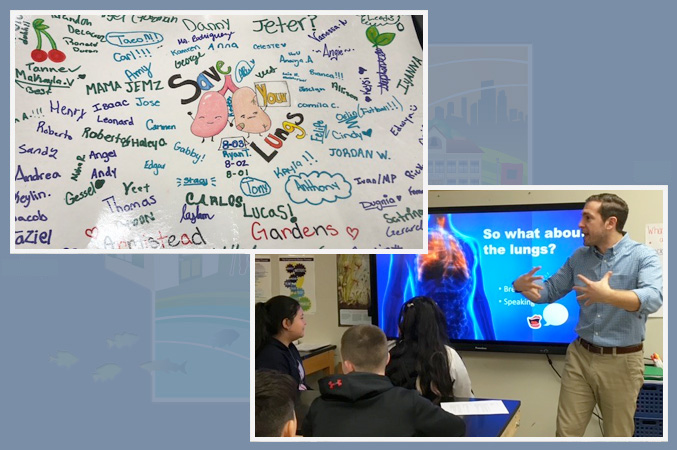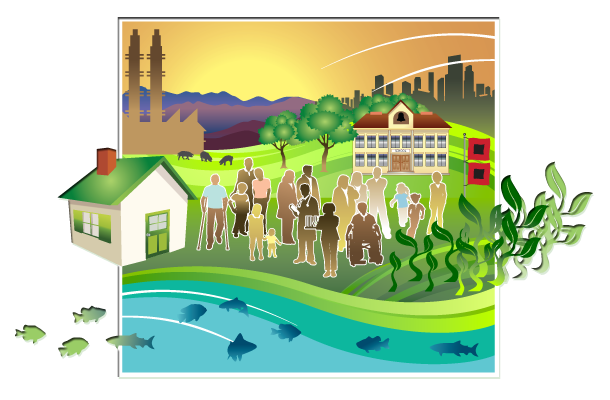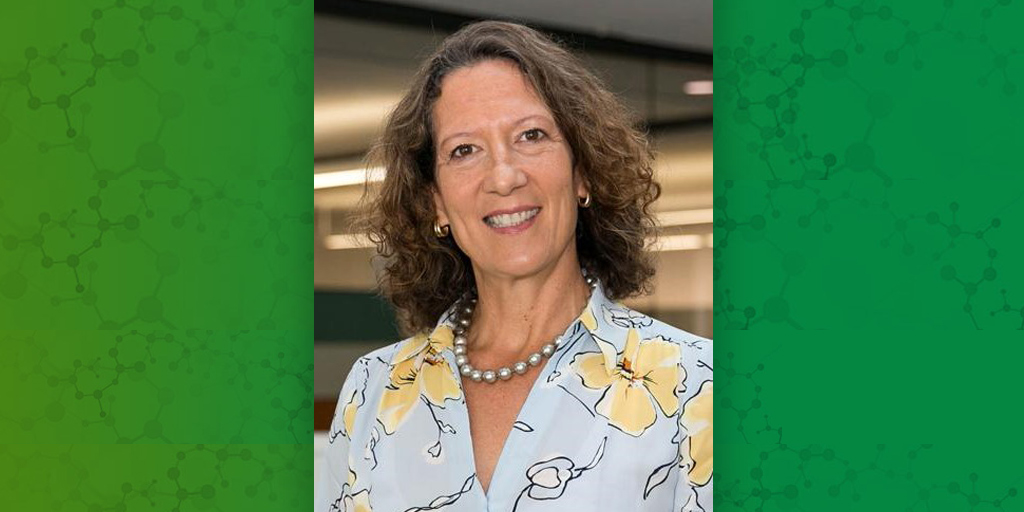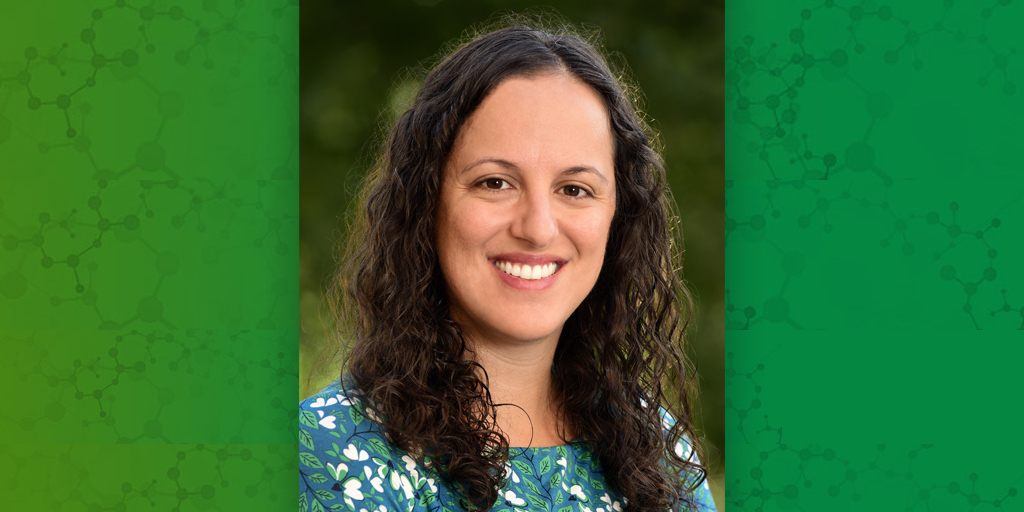Lung Health Ambassador Program Teaches Students Dangers of Tobacco Use
The Lung Health Ambassador program, a community-based, NIEHS-supported educational campaign with a focus on health disparities, promotes healthy behaviors and risk prevention around lung health for Baltimore-area students in grades 7-12. The program also engages students in advocacy activities, such as letter writing, aimed at supporting lung health and decreasing air pollution in their own communities. A recent paper describes the program and an evaluation of the program’s first year in greater detail.
Baltimore has a higher prevalence of smoking than the U.S. national average, and some tobacco stores are easily accessible to minors. Through the Lung Health Ambassador program, Johns Hopkins researchers empower Baltimore-area youth to be advocates for lung health in their own communities. The program’s goal is to train young students in matters related to lung health and pathology, risk factors, and ways to advocate for clean air.
The program is hosted by Johns Hopkins’s Medicine for the Greater Good, which promotes health and wellness for diverse populations through community partnerships that address socioeconomic barriers to health. The Lung Health Ambassador program will begin its fourth year in fall 2021.
“Tobacco use has created health disparities for people of certain races, ethnicities, and socioeconomic statuses, and it’s also the leading cause of preventable health problems,” said Panagis Galiatsatos, M.D., co-founder and co-director of Medicine for the Greater Good and founder of the Lung Health Ambassadors program. “Given Baltimore’s diverse population and high rates of smoking, we wanted to address lung health and tobacco use in youth, which could reduce future smoking. So, we started the Lung Health Ambassador program with a focus on pulmonary-related health disparities.”
Baltimore-area schools and recreation centers interested in the program can volunteer to have it implemented in their community.
The Lung Health Ambassador Program’s Structure
The Lung Health Ambassador curriculum consists of five sessions: lung anatomy and function, asthma, environmental air pollution, smoking and tobacco, and ambassador training. Researchers and teachers worked together to create the lessons. Each has didactic and hands-on components, such as building model lungs and creating plans to reduce the impact of peer pressure on smoking, to help maintain student interest and reaffirm learning objectives. The program ends with a graduation ceremony, with each student becoming a certified Lung Health Ambassador.
During the program’s inaugural academic year of 2018-2019, the curriculum was administered at two middle schools, one high school, and two recreation centers.

Students participating in the Lung Health Ambassador sessions (bottom, right) and a poster signed by student participants (top, left). (Photo courtesy of Panagis Galiatsatos, M.D.)
The Lung Health Ambassador Program’s Impact on Youth
During the program’s sessions, both teachers and students were given the opportunity to provide feedback. Participant feedback indicated that youth identified with what they were learning because of the program’s focus on health disparities. For example, one student remarked that it bothered him to see that being poor means a person may smoke more, and this realization made him want to protect his community. Another student was excited about the opportunity to help make laws to protect his friends from lung diseases.
“The program’s focus on health disparities proved critical in making content relevant to Baltimore youth. Students learned the material and realized it actually applied to people they knew – it wasn’t just an abstract idea,” said Galiatsatos.
Other students’ comments reflected an understanding that risks to lung health were relevant to them as youth. One student realized that harming lungs at a young age will keep them from reaching their potential, and another said that air pollution is about air in his home. Some students also express an increased interest in science and medicine after participating in the program.
“The hands-on component brings everything full circle and helps students understand the gravity of lung health,” said Galiatsatos. “They then get to apply everything they’ve learned to an advocacy project.”
Lung Health Ambassador Training Leads to Community Activism
The ambassador training makes the program stand out from traditional classroom teaching. During the training session, students create action plans to improve lung health and reduce air pollution in their own communities. They carry out these plans over the summer, thus building community capacity and environmental health literacy.
Students conduct a variety of actions to inform change. In 2018-2019, 268 youths participated in the program, and 240 of them wrote letters to local politicians, such as Maryland’s governor, to advocate raising the legal age for acquiring tobacco products from 18 to 21. In February 2019, three high school students provided testimony to state leaders to show support for Tobacco 21, a federal law enacted in 2019.
Another major student advocacy project was creating a smoke-free environment for property around participating recreation centers, including playgrounds and basketball courts. Students created and posted signs promoting smoke-free outdoor areas at the beginning of the recreation center’s summer season. The second and third years of the program had additional discussions about air pollution, and students gave presentations about how to reduce air pollution in their neighborhoods.
“We were excited to see that the first year of the program was such a success – we reached hundreds of students who enacted varied projects to improve lung health in their own communities,” Galiatsatos said. “We’ve already implemented the program three times and are continuing to learn a lot about how to best reach youth and communities about lung health. Our immediate next steps are to figure out how to reach more diverse communities and how our program can be adapted for other respiratory-related health issues.”
Effectively Disseminating Environmental Health Research Findings to Navajo Communities
Reporting back public health research findings to communities is an important aspect of research, but not all report-back methods are equally successful. A recent paper, Approaches for Disseminating Environmental Research Findings to Navajo Communities, discusses three dissemination approaches for reporting back environmental research results to Navajo communities. Each of the approaches had been used previously on different projects related to mining on the Navajo Nation. The first approach of using radio messages and flyers to announce dissemination meetings was the least personal and was minimally effective since meetings were poorly attended. The second method involved working with grassroots groups and was more effective, with larger numbers of community members attending the report-back meetings. In the third approach, the researchers developed a booklet for distribution to communities along with an oral presentation at regularly scheduled monthly community meetings. In the paper, the authors discuss the methods in greater detail and general lessons learned from their comparisons.
Three Strategies to Clearly Communicate Public Health Risks
The NIH has published strategies for communicating public health risks and changing risks in a recent commentary, How to Convey Changing Risks. It addresses the need to accurately communicate risk to the public in a way that is easily understood and promotes behavior change. The first strategy is to identify clear risk categories that are linked to data. These can include visual categories such as colors or numbers that clearly and simply demonstrate the chance that something will occur. The second strategy is to describe the actions that should be taken. People should be able to understand what behaviors are or are not recommended for each risk category. The third strategy is to carefully think about how to communicate changing recommendations with consideration to how people may interpret new information and to state the reason for the change. To read additional perspectives on communication strategies in public health and science, see the NIH’s Science, Health, and Public Trust resources.

PEPH Environmental Health Chat Podcast Series
Eating a Healthy Diet to Protect Against Pollution
PEPH Environmental Health Chat Podcast Series
Eating a Healthy Diet to Protect Against Pollution
You can find more podcasts on the Environmental Health Chat webpage or subscribe to the series on iTunes. We want your feedback! Send comments and ideas for future podcasts to [email protected].

PEPH Grantee Highlight
Diana Rohlman, Ph.D.
Diana Rohlman, Ph.D., translates environmental health research into community action by creating targeted communications and promoting health literacy. Rohlman is the director of the Community Engagement Core at the Oregon State University (OSU) Environmental Health Sciences Center. She also serves as co-lead at the OSU Superfund Research Program Center. The OSU centers work with Indigenous populations and underrepresented communities to develop research strategies that address resident concerns about environmental contaminants in their own communities. The centers also prioritize reporting back the results of the research in a way that is culturally sensitive and meets the communities’ needs. For example, when Rohlman and her team found that traditional Indigenous practices, such as burning candles, exposed people to polycyclic aromatic hydrocarbons, the researchers developed infographics that described how to reduce exposure while maintaining traditional practices. Rohlman and the OSU teams have found that tailoring information to a specific community and cultural practices increases the likelihood of residents practicing mitigation measures, and thereby reducing exposures.
Funding Opportunites
Understanding and Addressing the Impact of Structural Racism and Discrimination on Minority Health and Health Disparities (R01 Clinical Trial Optional)
This initiative will support (1) observational research to understand the role of structural racism and discrimination in causing and sustaining health disparities, and (2) intervention research that addresses structural racism and discrimination in order to improve minority health or reduce health disparities. NIEHS is interested in observational research examining the role of structural racism and discrimination as a significant determinant in environmental health disparities, or evidence-based intervention research that mitigates or prevents the negative health outcomes attributable to environmental structural racism and discrimination. Applicants are strongly encouraged to utilize community engaged research approaches and include letters of support from community partners. Applications that demonstrate collaborative (i.e., community-academic partnerships) approaches to understand and/or address the negative health effects of environmental structural racism and discrimination across multiple health disparity communities will be prioritized. Areas of specific interest to NIEHS include, but are not limited to: single or combined environmental exposures affecting the health of communities; health impacts of climate change, extreme weather and natural or human caused disasters; the built environment and greenspace, including green gentrification; studies grounded in community identified concerns around the intersection of environmental structural racism and discrimination and health outcomes; the impact of environmental structural racism and discrimination on health outcomes across the lifespan; and the role of environmental structural racism and discrimination in occupational exposures.
Deadline: August 24, 2021
Letter of Intent Deadline: July 20, 2021
Support for Research Excellence – First Independent Research Award (R16 Clinical Trial Not Allowed)
The purpose of the Support for Research Excellence – First Independent Research (SuRE-First) awards is to support research grants for faculty investigators who have not had prior independent external research grants. A SuRE-First applicant must identify a scientist based in the U.S. with expertise and an extramural funding record in the proposed field of research to serve as a mentor. SuRE-First-supported projects must have student participation in the execution, analysis, and reporting of the research. Awards are open to institutions that receive no more than $6 million per year from NIH Research Project Grants and additionally enroll at least 25% of undergraduate students supported by Pell grants, or are an accredited medical/health professional school with a historical mission statement that explicitly states that it was founded to educate students from nationally underrepresented backgrounds.
Deadlines: September 28, 2021; September 28, 2022; September 28, 2023
Addressing Health Disparities Among Immigrant Populations Through Effective Interventions (R01 Clinical Trial Optional)
Supports research to design and implement effective interventions to enhance health advantages and reduce the health disparities among U.S. immigrant populations, particularly migrant workers, recent and first-generation immigrants. This announcement calls for multidisciplinary/multilevel research focusing on the design and implementation of effective interventions that will address immigrant-specific factors to reduce health disparities. A framework to demonstrate the multidomain, multilevel factors that may influence health disparities is available here. A life-course perspective is encouraged with interventions focusing attention on transition points across the lifespan and associated risk and protective factors for immigrant populations. Projects should involve collaborations among relevant stakeholders in U.S. immigrant population groups, such as researchers, community organizations, healthcare providers, public health organizations, consumer advocacy groups, and faith-based organizations. Projects must focus on immigrants from one or more NIH-designated populations that experience health disparities in the U.S., which include racial and ethnic minorities (Blacks or African Americans, Hispanics/Latinos, Asian Americans, and Pacific Islanders).
Deadlines: February 5, 2021; June 5, 2021; October 5, 2021
Addressing the Etiology of Health Disparities and Health Advantages Among Immigrant Populations (R01 Clinical Trial Not Allowed)
Supports innovative research to understand factors uniquely associated with the immigration experience that contribute to health disparities or health advantages among U.S. immigrant populations, particularly migrant workers, recent and first-generation immigrants. This announcement calls for multidisciplinary research to address the specific underlying causes and mechanisms of health disparities and health advantages. A framework to demonstrate the multidomain, multilevel factors that may influence health disparities is available here. Projects should involve collaborations among relevant stakeholders in U.S. immigrant population groups, such as researchers, community leaders and organizations, public health organizations, consumer advocacy groups, faith-based organizations, and healthcare providers. Projects must focus on immigrants from one or more NIH-designated populations that experience health disparities in the U.S., which include racial and ethnic minorities (Blacks or African Americans, Hispanics/Latinos, Asian Americans, and Pacific Islanders).
Deadlines: February 5, 2021; June 5, 2021; October 5, 2021
Dissemination and Implementation Research in Health (R01 Clinical Trial Optional)
Supports innovative approaches to identifying, understanding, and developing strategies for overcoming barriers to the adoption, adaptation, integration, scale-up and sustainability of evidence-based interventions, tools, policies, and guidelines. Additionally, there is a benefit in understanding circumstances that create a need to stop or reduce (“de-implement”) the use of interventions that are ineffective, unproven, low-value, or harmful. This FOA invites research grant applications that will identify, develop, test, evaluate, and/or refine strategies to disseminate and implement evidence-based practices (e.g. behavioral interventions; prevention, early detection, diagnostic, treatment and disease management interventions; quality improvement programs) into public health, clinical practice, and community (e.g., workplace, school, place of worship) settings. Studies to advance dissemination and implementation research methods and measures are also encouraged.
Deadlines: February 5, 2021; June 5, 2021; October 5, 2021
Letter of Intent: Due 30 days prior to the application due date
The Role of Work in Health Disparities in the U.S. (R01 Clinical Trials Optional)
Supports innovative population-based research that can contribute to identifying and characterizing pathways and mechanisms through which work or occupation influences health outcomes and health status among populations with health and/or health care disparities, and how work functions as a social determinant of health. Of particular interest are projects designed to examine pathways and mechanisms using conceptual models grounded in minority health and health disparities theories that recognize that health disparities arise by multiple and overlapping contributing factors acting at multiple levels of influence. Studies must examine NIH-designated U.S. health disparities populations. NIEHS is interested in applications that focus on the intersection of work as a social determinant of health, the physical environment (that includes exposures to toxicants), and other social determinants of health in creating or intensifying environmental health disparities at the population level. Community engaged research approaches are strongly encouraged as well as applications that move the science of environmental health disparities towards achieving environmental justice for affected populations.
Deadline: October 5, 2021; February 5, 2022
Transition to Independent Environmental Health Research Career Award (K01 Independent Basic Experimental Studies with Humans Required)
The Transition to Independent Environmental Health Research career award is a 3-year bridge scholar development program for newly independent faculty who intend to pursue research careers in environmental health sciences. This funding opportunity is designed for applicants proposing to serve as the lead investigator of an independent clinical trial, a clinical trial feasibility study, or a separate ancillary study to an existing trial. For applicants not planning independent basic experimental studies with humans, there are two companion funding opportunities. Applicants planning independent clinical trials with specific application toward processes or with products in mind, must apply to the companion funding opportunity announcement, Transition to Independent Environmental Health Research Career Award (K01 Clinical Trial Required). Applicants not planning an independent clinical trial, or proposing to gain research experience in a clinical trial led by another investigator, must apply to companion funding opportunity announcement, Transition to Independent Environmental Health Research Career Award (K01 Clinical Trial Not Allowed). At the conclusion of the career development period the candidates are expected to demonstrate they can successfully compete for research funding in the environmental health sciences. Eligible candidates for the K01 award must have a research or health-professional doctoral degree and must be within three years of their appointment to their first independent faculty position at the time of submission (receipt date) of the application.
Deadline: October 12, 2021
Research on Autism Spectrum Disorders (R01 Clinical Trial Optional)
This award supports research designed to elucidate the etiology, epidemiology, diagnosis, and optimal means of service delivery in relation to Autism Spectrum Disorders (ASD). The Research Project Grant (R01) mechanism supports discrete, specified projects based in scientific areas that represent the investigators’ specific interests and competencies, and that fall within the mission of the participating NIH Institutes and Centers. Additional companion funding opportunities are available for a Small Research Grant (R03) which supports small, discrete, well-defined projects that can be completed in two years and that require limited resources (Research on Autism Spectrum Disorders (R03 Clinical Trial Optional)); and an Exploratory/Developmental Grant (R21) which encourages exploratory/developmental research by providing support for the early and conceptual stages of project development (Research on Autism Spectrum Disorders (R21 Clinical Trial Optional)). Basic research into the pathophysiology of ASD, including research on brain mechanisms, is of special interest. Also, of high priority are clinical and applied investigations that may lead to the development of new treatments and interventions.
Deadlines: June 16, 2021; October 16, 2021
NIH Blueprint and BRAIN Initiative Diversity Specialized Predoctoral to Postdoctoral Advancement in Neuroscience (D-SPAN) Award (F99/K00 Clinical Trial Not Allowed)
The NIH Blueprint and Brain Research through Advancing Innovative Neurotechnologies (BRAIN) Initiative Diversity Specialized Predoctoral to Postdoctoral Advancement in Neuroscience (D-SPAN) Award is intended for individuals who have demonstrated an interest in a neuroscience research career in NIH Blueprint mission-relevant areas and/or BRAIN Initiative research areas. This award will support a defined pathway across career stages for outstanding graduate students from diverse backgrounds, including those from groups underrepresented in biomedical and behavioral sciences. This two-phase award will facilitate completion of the doctoral dissertation and transition of talented graduate students to strong neuroscience research postdoctoral positions and will provide career development opportunities relevant to their long-term career goal of becoming independent neuroscience researchers.
Deadlines: December 15, 2021; April 15, 2022; December 15, 2022; April 14, 2023; December 15, 2023
Letter of Intent: Due 30 days prior to application due date
Notice of Intent to Publish a Funding Opportunity Announcement for Virtual Consortium for Translational/Transdisciplinary Environmental Research (ViCTER) (R01 Clinical Trial Optional)
Intent to reissue a funding opportunity announcement for the ViCTER award. The ViCTER program fosters and promotes early-stage transdisciplinary collaborations and/or translational research efforts among fundamental (technology and mechanism oriented), clinical (patient-oriented), and population-based researchers in the environmental health field. This funding opportunity will use the R01 mechanism and will bring together newly established collaborative teams to investigate potential linkages between human health and one or more environmental stressor(s). The ViCTER program is intended to support innovative high-risk, high-reward cross-disciplinary and/or translational research projects that are more difficult to achieve in a typical R01 application. Collaboration among investigators at different institutions through a virtual consortium arrangement are highly encouraged.
Deadline: February 1, 2022










